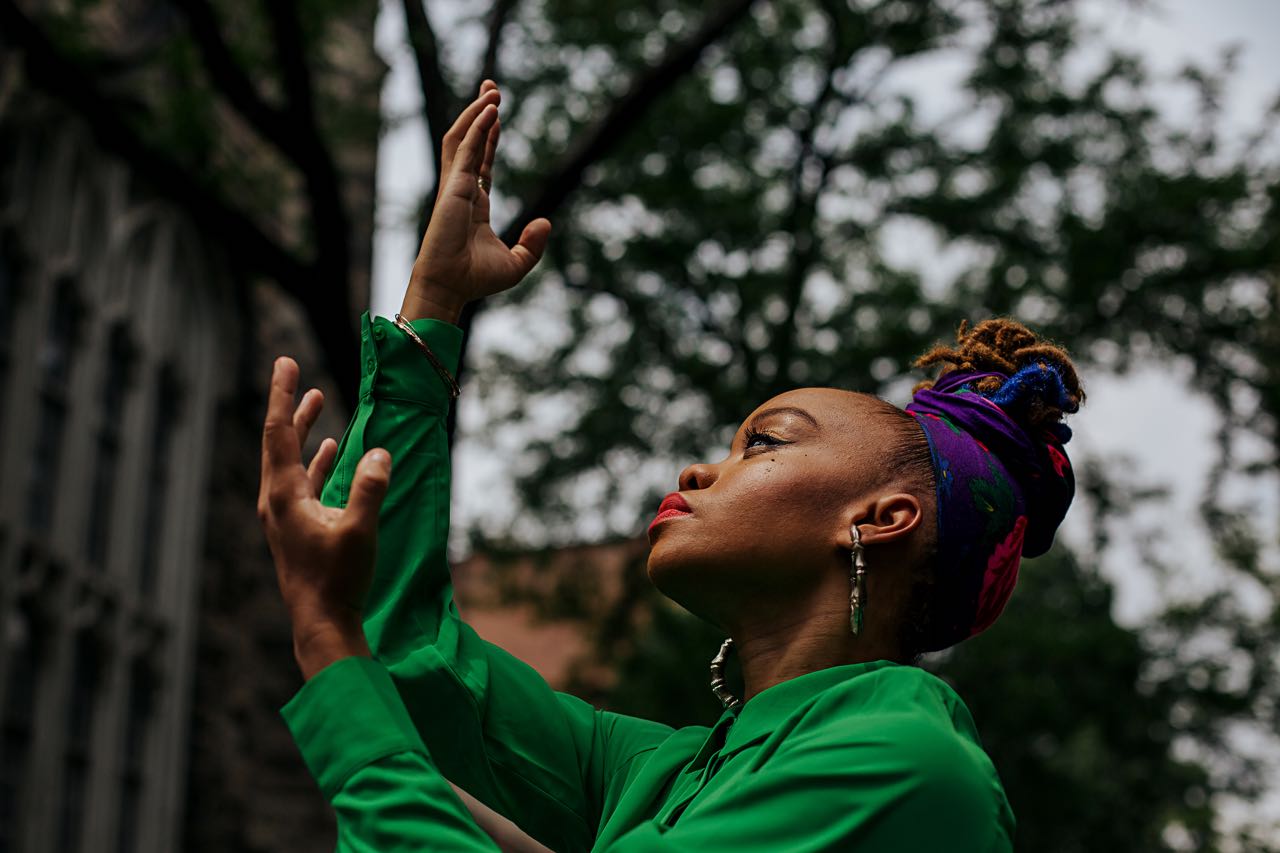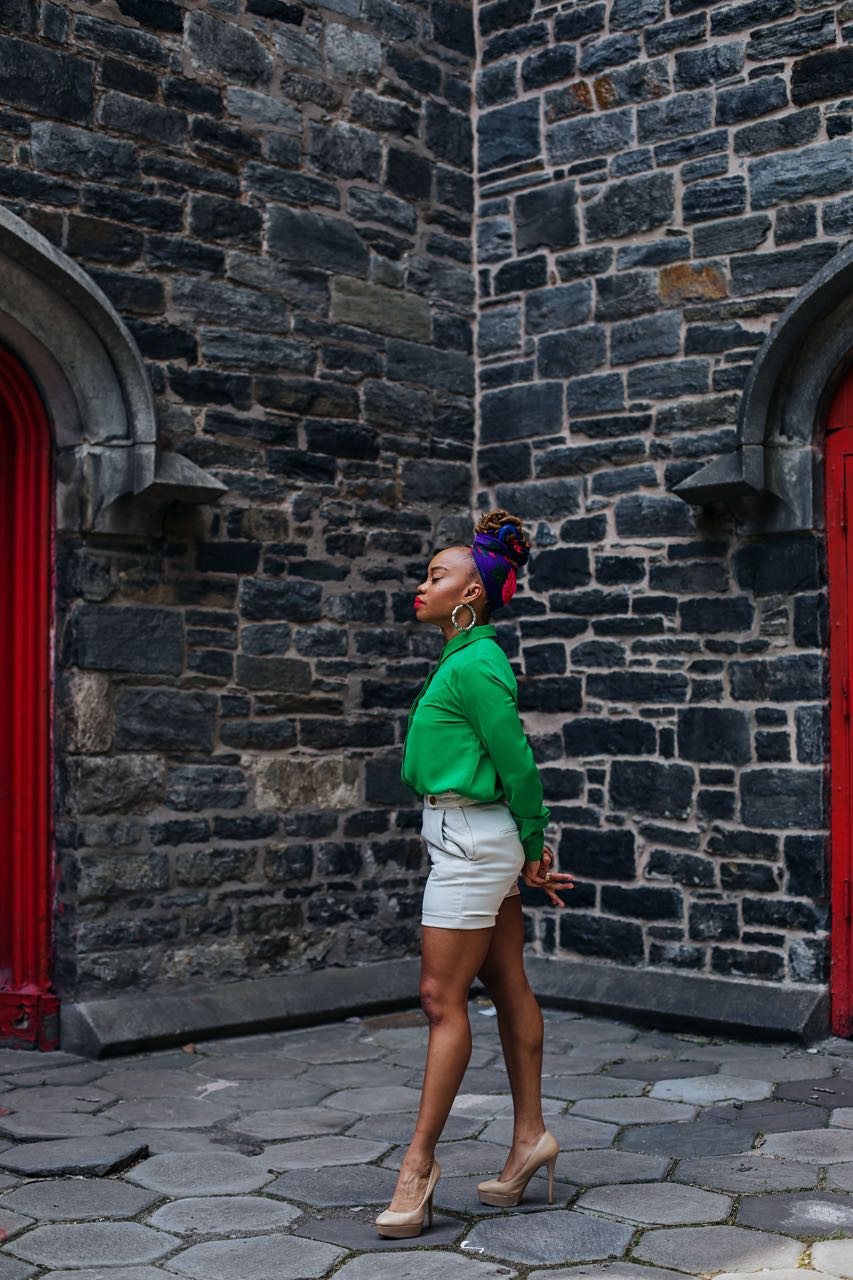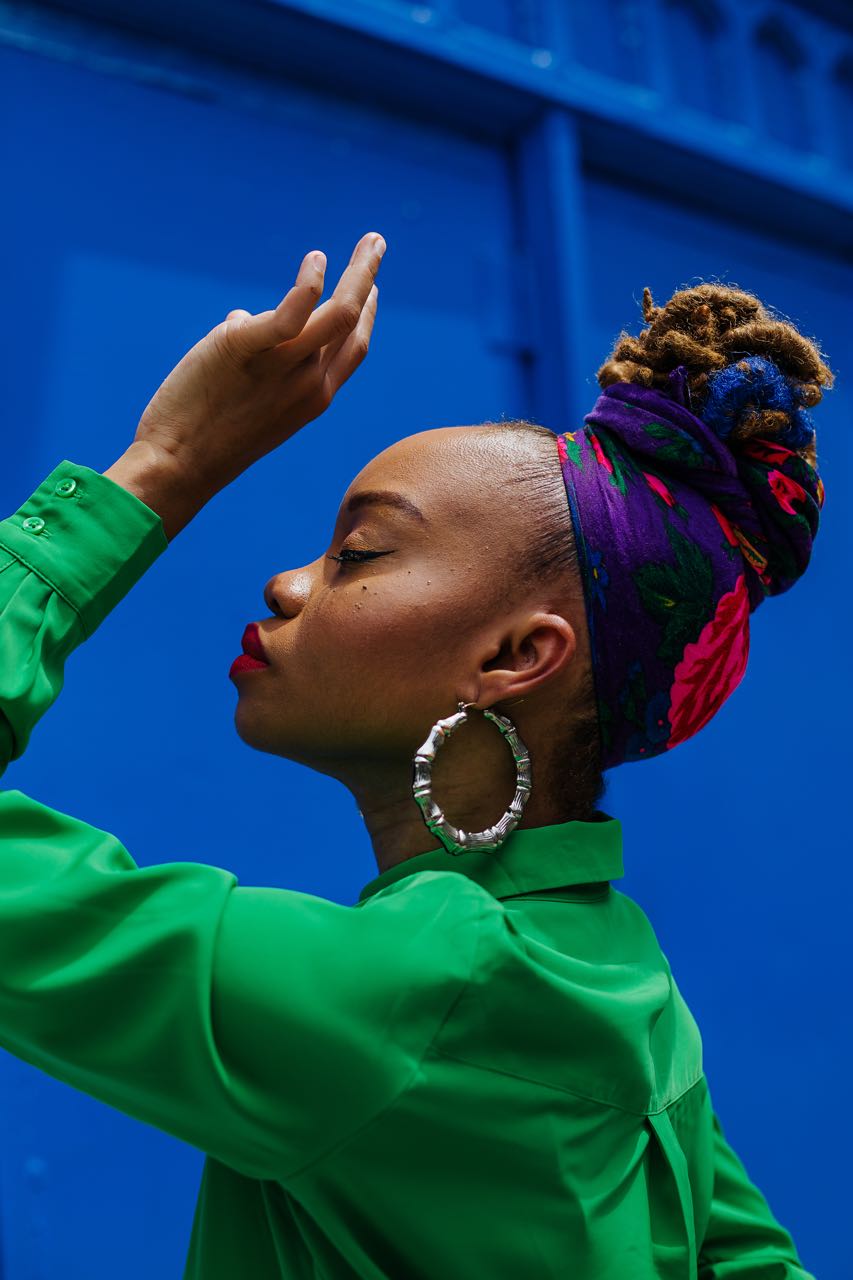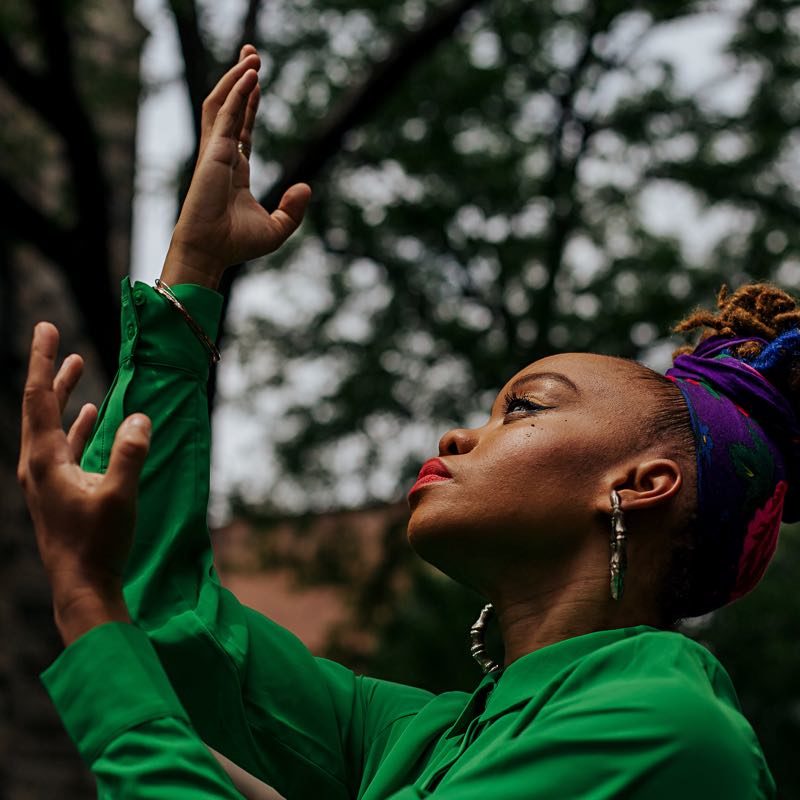An Interview with Camille A. Brown

July 24th, 2018
The past nine months have been full of firsts for choreographer Camille A. Brown. She made her Broadway debut as the choreographer for the Tony-winning revival of Once On This Island (many people felt she was a noticeable omission from the Best Choreography nominations) and then, a few months later, she made her television debut as the choreographer for NBC’s live broadcast of Jesus Christ Superstar. In addition to having her own company, Camille A. Brown and Dancers, her choreography can be seen in Atlantic Theater Company’s production of This Ain’t No Disco, a musical about the people who patronized Studio 54. I recently spoke with Camille about her process, reframing dance from the ‘70s, her goal of becoming a director/choreographer, and more.
What was your starting point for this project and coming up with all the choreography?
It’s staged around Studio 54, which meant that this is the disco era, so it was about understanding what those social dances are. I’m pretty familiar with social dances throughout time, so it was just about pinpointing that specifically. The disco era is very tricky because a lot of things that we see in Saturday Night Fever for example were actually done by Don Campbell and The Lockers three or four years before. So the challenge is, how do you show something that is familiar to people, but also contribute to reframing the narrative and lifting up those voices that basically were appropriated?
Do you start with a ton of research, or do you start with your initial creative impulses? How do you balance those two?
It’s a little of both. I do the things at the same time, so I do some research reminding myself what social dances are, but choreography is not just about implementing what you see. It’s also about creating your voice. It’s thinking about how you translate this your way because anybody can take dances and put them into a show, but it’s the composition of it that’s really exciting to me. The wonderful thing about this show is that it required me to pull from not just the 70s, but modern dance and Cunningham and Andy Warhol and what he was inspired by. So that connects me to other languages besides just the quote-unquote “disco language.”
When you’re putting it together, do you get up and dance through every track yourself, or do you see it in your head first?
I see it in my head, and then cross my fingers and hope that what I’m seeing actually can make sense when I see it on bodies. But it’s not just about me putting it on people. It’s about taking in who is actually in the space with me. So it’s about the choices of those actors and the space, too. I’ll give a structured step, but then I’ll ask them to create choices based on that. My work is being informed by the choices that they’re making.
One of the things that seems like it would be overwhelming about choreography is how you figure out everyone’s track and all the stage pictures. How do you keep all that in your head and decide, okay, this ensemble number is going to do this, this is going to do this, and still make sure that it all works together?
It’s kind of like looking at a storyboard and creating an arc, so that’s what I try to do after I get out all my ideas for each individual piece. Then it’s about bringing those pieces together and figuring out, okay, are these actually living together cohesively? Are they still standing on their own? Are you doing too many familiar steps within two pieces? And just kind of tracking what that is.
Was there a particular number or moment that, to you, seemed the most clear right from the beginning? And did you have a number or a moment that was the trickiest and took you a long time to work out?
The one I would say that was the clearest for me was “My 54,” and that’s because it had an Egyptian theme. So it was doing research with that, but I kind of understood what the movement language was. You’re towing the line with appropriation in that number anyway, because that whole number, in a sense, is about appropriation because you’re taking a culture and you’re kind of putting it on and doing it in the midst of a party. So my challenge there was to make that artistic and make it something that is familiar, like I said, but not make it something that goes overboard and makes it a caricature of Egyptian dance. I think that was hard. So even though that was clear, that was also my challenge.
I would say the hardest one… well, it’s interesting, because when I was speaking to Darko [Tresnjak, director] about the show, there were originally only three movement scenes. But now there are a lot of movement scenes, so the challenge for me was coming into it and getting new information and being challenged with new things and having to implement things in a very short amount of time. I would say that was difficult. And I was working on another show at the same time, which also takes place in kind of the 70s. I was doing The Wiz, which was created in the 70s, and even though that one didn’t necessarily take place in the 70s, you still wanted to have that essence of what that is. So it’s about looking at those two shows, and there’s a different way of moving and trying to kind of differentiate that within my movement language.
But I would say the opening [was the hardest number]. Openings are always hard for me. They’re the most difficult thing because it sets the tone, it sets the movement language. You’re telling people how this show is going to move from the opening, so I would say that. I’m still working on it.

You mentioned earlier the idea of the late 70s being a period where people think they know what the movements are, and that how those movements have disseminated through popular culture isn’t always accurate in terms of what was going at the time and who actually created them, and that you wanted to reframe that. I was wondering if you could talk a little more about how you did that in practical terms?
Specifically, I told the company that we were not doing this [disco finger] because that is very much from locking and that’s something that people saw and perceived as one thing and they translated and basically took it and transformed it into something else. So that’s one of the ways that I do that. Just being aware of the things that were appropriated, that weren’t necessarily given credit and just not doing that. That’s pretty much how I did it. And they all started laughing because everybody knows this [disco finger] is the disco thing to do and the main step that people identify with, and that is the one that I said from the beginning I wasn’t using.
Are there any other dances or movements from that time that you wish people knew the history of in a different way?
The entire Saturday Night Fever was taken from Don Campbell and the Lockers and all of the people that had done that five years before. My friend has an incredible documentary called Everything Remains Raw and it’s by Moncell Durden and it goes back and forth and it shows the year of Saturday Night Fever, and then it goes back and shows when the Lockers actually did that very exact step years before. So it’s all there.
Was there anything in preparing for this and doing research that you found that was new to you? Or a surprising fact or interesting thing about the dance from that period?
Just that it’s a tough one. I knew the 70s disco era was going to be a challenge because out of all of the eras—like the 20s and the 50s and 60s and 80s— feel like the 70s is the one that people make the most fun of dance-wise. It kind of turns into a joke, you know? The challenge is to not create something that is a caricature of the disco in the 70s, which you see happen a lot with this era, and to just really keep it grounded. But also have fun with it too.
It’s about educating people, but it’s also about the entertainment, because these numbers should be fun, and for people who maybe did go to Studio 54, it should hopefully evoke some memories from that time. It’s about bringing all of that stuff and remembering the stuff that doesn’t usually get put in and putting it in.
You’ve had a big year, especially with Once On This Island and Jesus Christ Superstar. How has that been for you? From the outside, it always seems very exciting, but it’s a lot of hard work.
Both things I experienced were firsts. Jesus Christ Superstar was the first time I’ve done television. I was extremely nervous about that. It’s funny, because I would watch the live shows and go, “Oh, that would be really nice to have the opportunity to do that. That’s not going to happen any time soon. I don’t have experience. I’m going to have to build up to that.” And then it just happened this year. So there I was, and I said, “Well, I don’t know a lot about TV from behind the scenes, but I’m just going to take what I do know and trust that. And the stuff that I don’t know, I just have to realize there’s a very short amount of time that I have to digest this information, and so just be aware.”
Once On This Island was the first Broadway musical that I have done, and it was the first show that I have done in the round, so that was the challenge: how do you create a musical in the round? It’s my first Broadway show, it’s one of the most beloved shows in musical theatre history, so I had a lot of challenges. But once I got out of my head and just focused on the work, then I didn’t think about it. And even though Jesus Christ Superstar was seen by ten million people, I didn’t think about that the entire time. I was just focusing on the work, and one of the reasons why I was doing that was because of the incredible leadership of David Leveaux [director of Jesus Christ Superstar]. He made it really clear that it was about the work and the integrity and us just focusing and zoning in on that. I thought that was incredible and that was actually one of the best experiences that I’ve ever had in musical theatre.
How was going from working in the round to a proscenium to then TV?
I almost had to think of TV as in the round too. The cameras are integrated within the set so even though it’s the proscenium and we’re kind of staging it that way, the cameras are all around. They’re in the round so I had to just constantly keep on my toes about that. Alex Rudzinski, who was the camera director, was really amazing and awesome and we just talked through all of the scenes. That was the moment where I had to pick up very fast because the camera is telling a story and it’s completely different than theatre, because in theatre, you as the consumer have the opportunity to take in the whole picture, even if the lead is singing over here, you can choose to look at somebody just standing there. In television, they’re very specific moments, so it was really eye-opening to go from being used to that to then having another form of storyboard and still having to create the movement language within that.
Have you found that things in your career have changed in the last few months?
More people know about my work, so that’s great. I just hope that these opportunities create ways for me to get more opportunities. I think with more exposure sometimes it is also a challenge, because now everybody’s looking to see what you’re doing. So my work that I have to do is to make sure that even though I am getting a large amount of exposure, is to never change who I am, because I think it’s very easy to fall into that and to kind of start catering to what you think people expect of you. Now is when I have to stay true to who I am, and, hopefully, I get more opportunities.

I know you have your own dance company too. How do you think dance and theatre collaborate in ways that are exciting to you?
I love telling stories in concert dance, so if anything, me working in theatre has made me a better choreographer in general because I’ve always loved telling stories, I’ve always loved history and creating characters, and so it’s kind of like I’m in school every time I have a project. I get an opportunity to learn, and each choreographer has their own way of working, so I don’t want to speak for anyone else. But for me, my focus is storytelling and character, and I feel like being in theatre has definitely helped me to see in different ways, helped me to be a better leader—just working with other directors and seeing how they interact with their collaborators has made me a better collaborator when I am the director in my own company.
The importance of the story and creating arcs and taking people on a journey and how you make that happen, how you want them to feel. Concert dance is more abstract. I think you can get away with more abstraction there because musical theatre is who, what, when, where, how. It’s a little looser with concert dance and I love going back and forth between the two. I eventually want to transition into being a director/choreographer in theatre, so this is also giving me the tools to do that and hopefully I get opportunities in that area, too.
We do a lot of interviews with directors and they talk about leadership and how that is learned a lot. I’ve rarely heard choreographers talk about that as something that’s needed too. What was your process like for learning how to be a leader in a room full of people?
I have my own company, so I think that automatically makes me have to focus in on being a leader, and also just being around directors. Darko was an amazing, amazing leader and just to be in the room see how he interacts with everyone and how he has real, wonderful conversations with people about the goals really helped me.
Also, I took leadership classes because I wanted to work on my leadership skills as a director for my own company. I have dancers that are pursuing choreography careers as well, and I wanted to be a good example for them. I think it’s just important when you’re a leader to be the best leader that you can be, and that’s what I always strive to do. So working with different directors gives me an opportunity to learn from a lot of things that happen, because everything happens in theatre. So many things come up, and how people handle situations is really eye-opening.
What are your dreams for the next stage of your career in the coming few years? You mentioned you wanted to also direct for theatre.
That’s the next thing. That’s the one I’m hoping for. Each thing has stages. I never wanted to have a company, but then once I realized that commissions for other companies and teaching wasn’t something I necessarily wanted to do, and I really wanted to have a really intimate process with dancers, that’s when I started a company, so that was one stage. Then getting into musical theatre as a choreographer is another stage, and it happened at a very fast rate. When I told people I wanted to be in theatre, everyone would tell me, “You have to start as a performer in the show. And then you have to be an assistant, and then you get to be an associate, and then you get to be a choreographer.” But thanks to Daniel Aukin, who was the director of Fortress of Solitude, he gave me my first opportunity right out of the gate as a choreographer. So now, the next stage for me, I hope, is to direct and choreograph, because I’ve seen the wonderful work of Bill T. Jones, and the fact that he’s able to have his own company and create work that is for concert dance but also find a home as a director/choreographer in theatre I think is just masterful and I would love an opportunity to do something like that.

